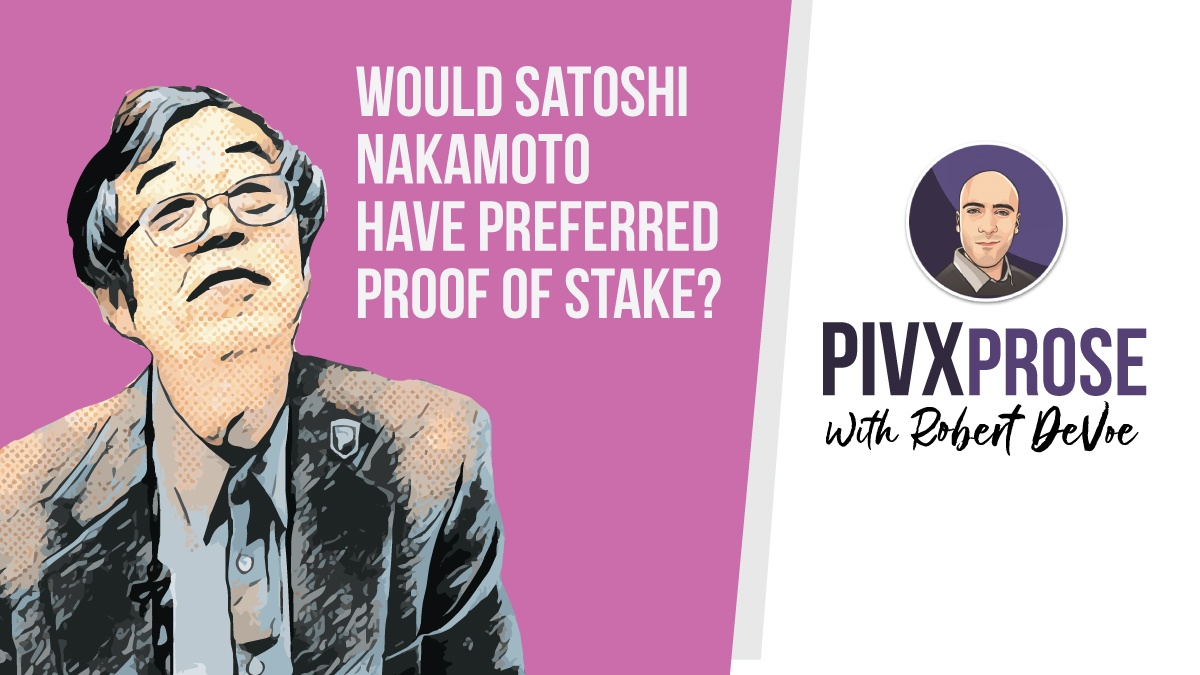Namely, PIVX is a Proof-of-Stake cryptocurrency (also known as PoS). A lot of our public dialogue has been about our privacy features which is indeed one of the core pillars that we base our currency on. However, that privacy is powered by Proof-of-Stake.
There are a lot of great explanations online for what Proof-of-Stake is that range from the simple to the extremely technical. For that reason, I won’t be going into what Proof-of-Stake is and I’ll be assuming that you at least have a general idea on that. Instead, I want to address some of the most common arguments against Proof-of-Stake that have always been around.
Specifically, I want to address the argument that Proof-of-Stake leads to an inevitable centralization of resources, a wealthy elite that is pulling the strings of the system, and that it is worse than Proof-of-Work in terms of centralization.
“Proof-of-Stake is Bad”
There are many different variants, but let’s go over some of the key features of a typical anti PoS argument.
As we all know, Proof-of-Stake rewards coin holders for holding their coins. The more coins a holder has, the more chances they have of winning a staking reward. The anti-PoS argument states that because of this, there will inevitably be a small group of ultra-wealthy individuals that will stake repeatedly and claim practically all the staking rewards for themselves. This will lead to a clique of ultra-rich that will continue getting richer as they gobble up block after block of rewards. This cycle then reinforces itself as the ultra-rich become even more capable of staking as their bags get heavier and heavier with coins.
To make things worse, this argument claims that this hypothetical clique of super-rich oligarchs will then be able to exert their power on market forces so as to shift the direction that the project goes. According to some arguments, the clique can even manipulate the price of the asset on open markets.
Proof-of-Stake Sucks – A Rebuttal
Let’s begin by going over this general argument piece by piece.
First I would like to address the idea that Proof-of-Stake is worse than Proof-of-Work in terms of centralization of power.
In order to be a successful miner on a cryptocurrency like bitcoin, one must at the very least be the owner of a sufficiently modern ASIC mining device. Anything less than an ASIC will result in a complete waste of time, energy, and resources on behalf of the miner.
Currently, sufficiently fast ASIC mining devices are only available from a small handful of suppliers – the vast majority of which are in mainland China. This means that the supply of these devices is strictly controlled by a small handful of for-profit corporations. It is up to these corporations to determine how many devices are available on the open market and when they become available.
Some incidents suggest that these companies create new and extremely fast hardware and run the machines themselves for weeks or months to earn a huge mining return before finally releasing the devices to the public. Evidence of this can be found leading up to the first Monero hard fork to prevent the launch of Monero compatible ASIC devices. The network saw a massive drop in hash rate once the algorithm was changed to one that was designed to be ASIC resistant. If all the miners on the Monero network were not using ASIC devices, the drop off of the hash rate should have been minimal and further should have quickly recovered once miners updated their systems to the new algorithm. Instead, the hard fork caused a drop of over 80% of the network hash rate. The fact that the hash rate dropped so dramatically and failed to recover is evidence that ASICs were already operating, despite none of them being available publicly.
With one key prerequisite of being a successful miner being that you must own a device that is sold by a private company that is trying to beat you to win the next block reward seems to be a fool’s errand, or at least a fight where the deck is completely stacked against you. Bitcoin proponents will be quick to argue that bitcoin mining is profitable. Under some circumstances that is true. However, it is clear that this mining market is manipulated and the ASIC manufacturers are the ones that are making the real money.
Who’s Really In Control?
Let’s assume that you’ve purchased an ASIC mining device. That’s great, but unfortunately just using an ASIC device and mining by yourself will likely yield in practically no return. Unless of course you get incredibly lucky and win an entire block for yourself. But since the odds of that happening are so low, practically all small-scale miners choose to join a mining pool. The most popular mining pools out there are typically controlled by – you guessed it – the ASIC manufacturers themselves.
But joining a mining pool to increase your chances of getting a reward is not free. On the contrary, mining pools charge a pool fee. In order to stand any reasonable chance of getting a reward, you not only need to buy a device on a manipulated market from a near virtual monopoly, but you also need to pay that company fees in order to get any chance of earning a small slice of the mining reward pie.
Now let’s compare this to Proof-of-Stake With Proof-of-Stake, there are no ASIC mining devices, or ASIC manufacturers, or mining pools and their pool fees. Instead, with Proof-of-Stake, each coin you hold gives you as equal a chance to earn the next block reward as a single coin held by anyone else. There is nothing you can do to make that single coin more likely to stake. You can’t buy a faster computer or promise your soul to a private company. Each coin is just as likely as any other coin to stake.
A reasonably apt analogy to explain this is to think of each coin as a reusable lottery ticket. With every block, a winner is chosen from all of the coins being staked. Logically, the more reusable lottery tickets you own, the more likely it will be that one of your tickets is a winner. There is no need to pay any fees to anyone in order to stand a reasonable chance of winning a block. In fact, PIVX has identified instances where an address with only a single PIV has managed to successfully win a block reward. Admittedly this is rare, but it is entirely possible.
Favoring the Wealthy?
The next part of the entire anti-Proof-of-Stake argument is all about how the supposed ultra-wealthy elite are able to gobble up all the block rewards because of their huge holdings. Further, this makes it worse and even more unfair than Proof-of-Work and its favoritism for industrial-scale miners and those that control the mining pools.
These naysayers’ main point is that you must hold a huge amount of coins to stand any reasonable chance to stake and the wealthy will always have the advantage.
Let’s consider this argument for a moment. On the surface, it is true that with PoS the more coins you hold, the more likely it is that you will win a block reward. However, this view is incomplete and misses some essential economic principles that need to be considered.
Let’s suppose for a moment that a major bank says they have decided that they will no longer give interest to their account holders based on a percentage of their deposits. Instead, as long as you hold an account with this bank and have a minimum deposit of roughly 1 US dollar, then you will receive the same amount of interest as every other account, regardless of how much is in it. The fallout of such a foolish decision is obvious. People would just create hundreds or thousands of accounts for themselves and collect the maximum amount of interest on the minimum required deposit. This, of course, is unsustainable and completely illogical which is why it would never happen.
The same can be said for Proof-of-Work coins. There needs to be an incentive to hold coins in order to earn a reward. Otherwise, there would be no value to buying and holding additional coins for staking. It would be simply pointless to hold more than one unit of the cryptocurrency if one wanted to earn mining rewards. Or rather, those looking to stake would simply split up their holdings into thousands or even millions of addresses to maximize their return. This kind of manipulation would bring the coin to its knees and completely destroy its market value.
Further, encouraging people to hold the coins helps restrict the floating supply and can stabilize prices over time. In general, we at PIVX believe that stable markets are better than ones that are constantly swinging upward or downward. We believe that providing logical and reasonable incentives to hold PIV is far better than trusting a small handful of for-profit companies to be in total control of our coin supplying and block reward distribution.
Finally, from a mathematical perspective, what ends up happening with PIV holders over the long-term is that no matter how many coins they hold, they end up receiving roughly the same amount from staking as a percentage of their staking holdings. To simplify, someone who holds a lot of coins will stake more often, and someone who holds fewer coins will stake less often.
However, generally speaking, this ends up so that each party is still earning roughly the same amount annually as a percentage. Most estimates say that staking PIVX yields approximately an 8% to 10% annual return. If staking 1000PIV earns you 80 to 100 PIV, and staking 100 PIV yields you 8 to 10 PIV, then the relative income percentage is approximately equal. We feel that this distribution model is far fairer while still encouraging people to hold more PIV rather than less.
Further, the ability to stake any amount of PIVX is far fairer than sticking to a purely masternode-based model which has a much larger minimum requirement. Hybrid coins like Dash that use both Proof-of-Work and masternodes suffer from both the high cost and centralization of ASIC mining, as well as the large minimum requirement to run a masternode. Only coins like PIVX offer a third option. Namely, the ability to stake any amount which allows for smaller players to still compete and stand a reasonable chance of earning rewards.
The Mysterious, Cloaked Super Elite Pulling the Strings
The last argument I want to address is the idea that Proof-of-Stake coins end up with a mysterious ruling elite that makes all the decisions and pulls all the strings behind the scenes. It’s easy to understand where this argument comes from, but it is for the most part of a fantasy.
I would like to use myself as an example. I came to the PIVX project as just a regular person. I didn’t hold hundreds of thousands of PIV and I certainly don’t consider myself rich or powerful by any reasonable standard. And yet I was able to step forward and lead the charge on all sorts of initiatives for PIVX. I’ve been able to help guide the project through both my actions and my budgetary proposals. I did all of this without any sort of cloak and dagger financial maneuvers.
I’ve seen the PIVX voting process firsthand and it is a highly democratic one. Having a PIVX masternode is something that anyone who is truly invested in the project (both financially and ideologically) can reasonably achieve. That means if your personal beliefs fall in line with that of the PIVX project, you too can take part as a masternode holder. Or you can take a similar path as I did and join the project with nothing more than your own skills and commitments to guide you.
Final thoughts
My goal here with this article wasn’t to declare Proof-of-Stake as flawless or bulletproof. There are going to be legitimate arguments for and against it and those that disagree with it – and I am very thankful for that.
It’s the fact that Proof-of-Stake and PIVX have stood up to regular scrutiny that we are stronger as a result. I wholeheartedly encourage anyone who has doubts about Proof-of-Stake to step forward and talk about them. Further, if you have any arguments against it or simply don’t like Proof-of-Stake, then, by all means, you can choose to support a different cryptocurrency that uses Proof-of-Work or another consensus model.
The PIVX project believes deeply in everyone’s right to freedom and personal choice. And if that means you choose to avoid Proof-of-Stake, then project members like myself will fully support your decisions. But for us, we believe that Proof-of-Stake is the ideal consensus model for the crypto world today. And we look forward to continually pushing the envelope on what Proof-of-Stake means and what it can do for all of us.





